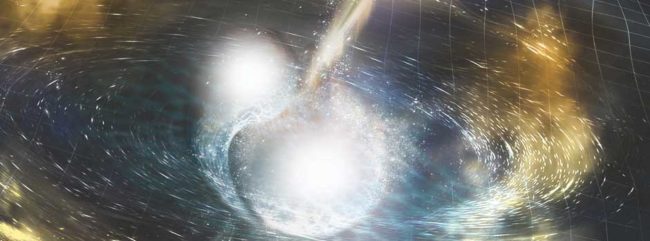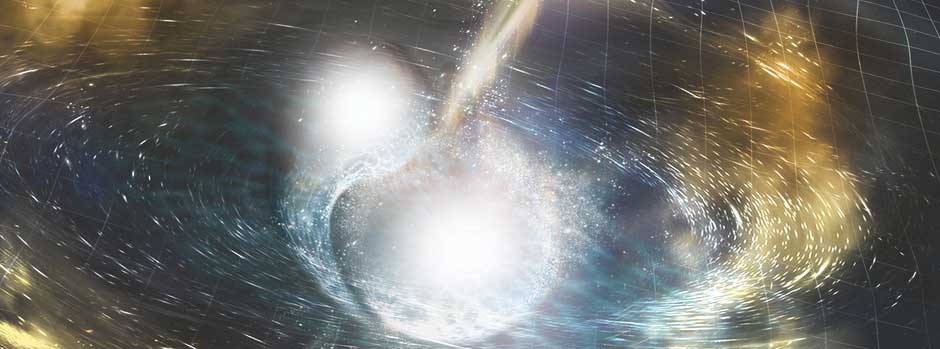
There has quite appropriately been an abundance of news and excitement regarding the first observation of gravitational-waves from a pair of inspiraling neutron stars. Most media outlets have been covering it, for example …
- Washington Post – Scientists detect gravitational waves from a new kind of nova, sparking a new era in astronomy
- The Guardian – New frontier for science as astronomers witness neutron stars colliding
- BBC – Einstein’s waves detected in star smash
- etc…
I don’t intend to do yet another rehash of the news, the journalists within major media outlets are doing a fine job at communicating it all. Instead I’d like to add two specific things to make a very specific and rather interesting point.
- The alpha source for the media stories: I’ll briefly point you at the primary LIGO press release that the various media outlets used. The various articles are of course fascinating, but often are simply just a rehash of the LIGO press release. So why read the articles when you can instead read their original source.
- The actual discovery paper.
But the real reason for highlighting the above is to point out that this is a milestone that marks the emergence of “multi-messenger astronomy”. If you are not sure what that means, then read on.
So let’s start with the first – what is the alpha source for all this news?
Press releases
LIGO have an official press release, but beyond that what is rather fascinating are all the “me to” press releases that have been popping up to hitch a ride on this shooting star. The Astronomer Phil Plait rather amusingly notes this …
I’m at 40 press releases and counting. https://t.co/ZBlOWhOTg8
— Phil Plait (@BadAstronomer) October 16, 2017
… as do others …
fully expecting to get a press release from the Acme Paper Clip Company explaining how crucial their paperclips were to the @LIGO/Virgo news
— Charles Bergquist (@cbquist) October 16, 2017
While the alpha is of course the Caltech LIGO one (dated 16th Oct), it is important to remember that this is a vast scientific collaboration that spans the globe. Seeing many associated press releases from others is a reflection of this.
LIGO is funded by the NSF, and operated by Caltech and MIT. Financial support for the Advanced LIGO project is not just the US NSF, it has also been funded by other nations. For example, Germany (Max Planck Society), the U.K. (Science and Technology Facilities Council) and Australia (Australian Research Council) made significant commitments and contributions.
More than 1,200 scientists and some 100 institutions from around the world participate in the effort through the LIGO Scientific Collaboration. All the partners involved are listed at http://ligo.org/partners.php
The Virgo collaboration consists of more than 280 physicists and engineers belonging to 20 different European research groups: six from Centre National de la Recherche Scientifique (CNRS) in France; eight from the Istituto Nazionale di Fisica Nucleare (INFN) in Italy; two in the Netherlands with Nikhef; the MTA Wigner RCP in Hungary; the POLGRAW group in Poland; Spain with the University of Valencia; and the European Gravitational Observatory, EGO, the laboratory hosting the Virgo detector near Pisa in Italy, funded by CNRS, INFN, and Nikhef.
To translate; because this is a vast collaboration we should expect to see many press releases. It is a wholly appropriate reflection of that reality.
The Discovery Papers
This is the alpha discovery paper published in APS Physics …
- GW170817: Observation of Gravitational Waves from a Binary Neutron Star Inspiral (open access)
Published in Phys. Rev. Lett. 119, 161101 (2017) - GW170817 Data Release
That however is not it. Again, as a reflection of this being a vast scientific collaboration, there are also many related papers as well …
- Multi-Messenger Observations of a Binary Neutron Star Merger (open access)
Published in Astrophys. J. Lett. - Gravitational Waves and Gamma-Rays from a Binary Neutron Star Merger: GW170817 and GRB170817A(open access)
Published in Astrophys. J. Lett. - A Gravitational-Wave Standard Siren Measurement of the Hubble Constant (currently free to read)
Published in Nature - Estimating the Contribution of Dynamical Ejecta in the Kilonova Associated with GW170817
Accepted by Astrophys. J. Lett. - GW170817: Implications for the Stochastic Gravitational-Wave Background from Compact Binary Coalescences
Submitted to Phys. Rev. Lett. - On the Progenitor of Binary Neutron Star Merger GW170817
Accepted by Astrophys. J. Lett. - Search for High-energy Neutrinos from Binary Neutron Star Merger GW170817 with ANTARES, IceCube, and the Pierre Auger Observatory (authored by the ANTARES, IceCube, Pierre Auger, LIGO Scientific, and Virgo Collaborations)
Submitted to Astrophys. J. Lett.
So what am I actually getting at here?
The degree of data sharing and collaboration that is happening here is itself unprecedented and new.
“LIGO and Virgo detected 100 seconds of gravitational waves as these two neutron stars spiraled together in a massive and fiery collision, In a sprawling follow-up campaign involving about one-quarter of the world’s professional astronomers, observatories in space and on the Earth have detected radiation in all wavelengths from gamma rays to radio waves. But the LIGO and Virgo detectors were absolutely essential in identifying and pinpointing the event in the sky, allowing this campaign to proceed”
– LIGO Hanford Observatory (LHO) Head, Michael Landry
The phrase I have underlined and highlighted in the quote above says it all. LIGO is not just the opening up of a new window on the universe, it has also seen the emergence of “multi-messenger astronomy”. This is where data from traditional telescopes, neutrino detectors, and now gravitational wave observatories are shared and compared to glean even deeper insights.
When the Astronomers become excited, then we should also be excited
Just knowing this stuff – just knowing that we CAN know this stuff – makes the Universe a cooler place to be.
— Phil Plait (@BadAstronomer) October 16, 2017
Your computer likely has some platinum in it. That metal was made in the colossal crash of two neutron stars forming a black hole. !!!!!!
— Phil Plait (@BadAstronomer) October 16, 2017
This really is HUGE. The merger made grave waves AND a visible flash! Able to see host galaxy, get spectra, figure out TONS of stuff. pic.twitter.com/VrAzgB75Cz
— Phil Plait (@BadAstronomer) October 16, 2017
One of the things that the #GravitationalWaves #NeutronStar collision discovery confirms is that light and gravity travel at the same speed
— Katie Mack (@AstroKatie) October 16, 2017
"Professor, why were you late to class?"
"Well, 130 million years ago, in a distant galaxy, these 2 neutron stars spiraled into each other…"— Robert McNees (@mcnees) October 16, 2017
Imagine being a DC fan and seeing the Bat-signal for real. That's how we felt when observing the emission from neutron stars back in August.
— Juan Carlos Munoz (@astro_jcm) October 16, 2017
Our #GW170817 infographic, available in many different languages!https://t.co/zdaCOhpA9A pic.twitter.com/i6UM14Z69I
— LIGO (@LIGO) October 16, 2017
